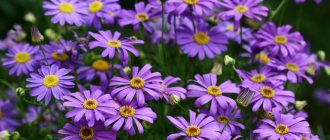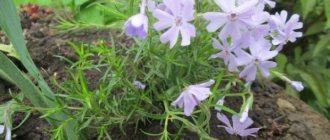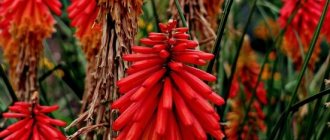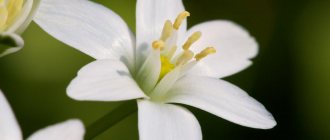Physostegia is a beautiful, unpretentious perennial that belongs to the Lamiaceae family. Many gardeners choose it for their flower gardens, and florists like to add it to bouquets and compositions. Tall flower stalks with numerous lush and bright buds look very impressive.
The homeland of these plants is North America. In nature they grow near bodies of water, near swamps. There are about 12 species in total, but only one is grown decorative in gardens - Physostegia virginiana. Its flowers are honey plants.
Physostegia. Description of the plant
Physostegia is a bright representative of the Lamiaceae family. In its natural environment, it can be found in the meadows of North America. And in cultivation, the plant is grown to decorate flower beds, garden paths and park areas, and to create mixborders. Physostegia is a herbaceous perennial plant. It forms dense clumps, consisting of strong, erect stems, up to 1.2 m high. The rhizome of the crop is creeping and quite aggressive. And if the growth of physostegia is not controlled, it will grow to its maximum area, displacing other plants from it.
The leaves of the crop with a lanceolate or oblong shape are located on the shoots in pairs. They are colored light green. Spike-shaped inflorescences reach 30 cm. They consist of 1- or 2-hollow tubular, two-lipped buds, painted in white, pink or lilac tones. The flowering period of the crop begins in early July and lasts until September. After it, the plant forms a fruit - a nut.
Description of culture
Representatives of the genus Physostegia from the Lamiaceae family are herbaceous, beautifully flowering perennials, common in North America. The genus has 3 species (according to other sources there are 13), in cultivation there is one species – Physostegia virginiana (P. virginiana). Varieties: Summer Spire, Summer Snow, Vivid, Variegata, Alba, Bouquet Rose, Crystal peak white, Pink queen.
The word "physostegia" consists of the words "physalis" + "stege", which translates as "bladder" + "tire". The name is associated with the peculiarity of the flower - the perianth is slightly swollen and resembles a bell in shape.
The height (60-120 cm) of erect, highly branched tetrahedral stems depends on the variety and growing conditions. The leaves with an uneven serrated edge are narrow, long, and arranged in pairs or oppositely. A distinctive feature is that the rhizome grows strongly, suppressing neighboring crops with a weaker root system. As the plant grows, it forms compact, bush-like clumps.
Spike-shaped vertical inflorescences 30-35 cm long consist of two-lipped tubular-swollen lilac, pink, white fragrant flowers. They begin to bloom from the bottom of the inflorescence, due to which it retains its decorative effect for a long time. At the end of flowering, a nut with seeds is formed, which, having ripened, scatter and promote reproduction by self-sowing.
There are many planting options: in groups along paths, fences, buildings, in composition with low-growing deciduous and flowering plants, in front of tall bushes, in clearings among trees. The varied colors of flowers allow you to create original single-color and multi-color compositions from different varieties of physiostegia on lawns and near ponds.
Types of physiostegia
There are 3 types of plants, but only Physostegia Virginiana is grown in culture.
And the best varieties are considered to be the following plant varieties:
- Physostegia is white. The culture reaches up to 80 cm in height. Its spike inflorescences, up to 30 cm long, are densely covered with flowers. Each of them reaches 2-3 cm in length. The petals are painted snow-white. This type of plant thrives in maximum light and moderately moist soil.
- Pink Queen. The height of the plant's stems reaches 75-80 cm. Its apical inflorescences are spike-shaped and colored in a rich pink hue. They open completely in water, so the flowers are suitable for cutting and making bouquets.
- Miss Manners. A compact variety, the height of which does not exceed 60-65 cm. Spike-shaped inflorescences reach up to 25 cm in length. They are painted snow-white. The variety is frost-resistant and can withstand up to -35 °C without shelter.
- Variegata. The variety reaches up to 90 cm in height. Its narrow, linear-lanceolate leaves have a white border along the edges. Inflorescences up to 30 cm long are painted deep pink.
- Alba . A tall variety, reaching up to 90 cm in height. It is distinguished by larger tubular buds collected in oblong inflorescences-spikelets. The petals are painted snow-white.
- Bouquet of Roses. The plant grows up to 1.2 m. This variety is distinguished by the bright lilac color of its petals.
Botanical description
The perennial physiostegia is a modest, at first glance inconspicuous plant that forms dense clumps. It has powerful erect tetrahedral shoots with a height of 60 to 120 cm. The rhizome of Physostegia is aggressive - creeping and growing, the leaves are oblong or lanceolate, sessile, paired or opposite, jagged along the edge. Tubular, two-lipped bisexual (less often unisexual) flowers of pink, white, lilac or purple are collected in spike-shaped inflorescences up to 30 cm long.
The flowers have a scent that attracts bees to the garden. Flowering begins in mid-summer and ends only in September. The fruit of Physostegia is a small nut.
Physostegia in garden design is very effective in small groups not far from paths. Physostegia is often grown around the perimeter of the garden along fences, in mixborders, as well as around fountains and ponds. Phlox, echinacea, dahlias, thujas, dwarf spruce and juniper are used as partners of physiostegia in the design. Planting a Physostegia flower and caring for it are so simple that one could not even describe them.
- Thyme (thyme): growing in the garden, varieties
Conditions for keeping the plant in open ground
Physostegia, a photo of which is given in the article, is one of the most unpretentious plants. But without proper care, the culture will lose its decorative effect. And to avoid this, you will need to occasionally water and fertilize the plant, as well as choose the optimal place for planting it.
Lighting
Physostegia is a light-loving plant, and for it it is worth choosing well-lit areas or partial shade. In complete shade, the crop will quickly lose its decorative effect and may even die. It is also advisable to select an area for the flowerbed that is protected from the wind, since sharp gusts can break off the flower stems.
Temperature
Physostegia develops well at temperatures of +14…+25 °C. But it can also easily withstand the summer heat, but at such times you will need to water the crop more often. It is also a frost-resistant plant and can withstand temperatures as low as -35 °C. But if the winter turns out to be snowless, the plant may die. So it is advisable to prepare it for the cold period. To do this, you will need to trim the shoots of the flower, leaving stumps up to 5 cm long, and cover the bush itself with non-woven material, such as lutrasil, or sprinkle it with fallen leaves and conifers.
But you need to remove the shelter immediately after the temperature reaches above zero. Otherwise, the roots of the culture may be lost.
Humidity
Physostegia does not require high air humidity. But such conditions will not harm the culture. So it can be planted near bodies of water, and during particularly dry periods it can be sprayed with water from a spray bottle. But it is better to hold such an event early in the morning or at sunset. Otherwise, under the influence of the sun, the water drops will become very hot and cause a burn on the leaves and stems of the plant.
Soil and drainage
Physostegia takes root on any type of soil, with the exception of very clayey and depleted soils. But it is better to plant the crop on fertile, light black soil or sandy loam. The plant does not tolerate stagnation of moisture at the roots, so it should not be grown in lowlands, in wetlands and in places with close groundwater. It is also advisable to arrange drainage. To do this, at a depth of 40-50 cm, lay out a layer of broken brick, fine crushed stone or river sand.
Watering
Physostegia (planting and care, photos of the culture are given later in the article) refers to drought-resistant plants. And it is important to water it during especially hot and dry periods, keeping the soil moist and loose. When the soil dries out, Physostegia sheds its lower leaves, which negatively affects its decorative properties. And with prolonged drought, the crop may die. In spring and autumn, when the weather is cool, it is better to completely abandon watering. Indeed, in such conditions the plant can rot.
For irrigation, you can use water directly from the well. But it is better to preheat it in the sun so that the plant does not experience stress from temperature changes. It is advisable to carry out irrigation itself in the early morning or at sunset.
After watering or rainfall, it is important to loosen the soil in the flowerbed. Otherwise, a crust will form on it, which will block the access of air to the roots. You will also need to weed around young plants. To make caring for physiostegia as easy as possible, it is better to mulch the surface of the flowerbed with peat, compost or rotted manure. This layer will help keep the soil in the ground and prevent a crust from forming on its surface. Thus, the number of waterings and loosening can be significantly reduced.
Trimming and restrictions
Physostegia roots grow quickly, and in a short time the culture can cover a large area. And in order to limit the plant, it is necessary to dig pieces of slate, plastic or wooden fencing around the perimeter of the flowerbed to a depth of 30-40 cm. You can also plant shrubs in buckets without a bottom. To maintain the shape of the plant, it is necessary to regularly trim young shoots, as well as shorten shoots that are too elongated. It is also necessary to remove faded inflorescences, but at the same time you need to leave stumps 3-5 cm long.
If you cut the plant at the root, then next year its flowering will be less lush.
Physostegia after flowering
How and when to collect seeds
Large black ribbed seeds of Physostegia are formed in cups at the bottom of the bracts, but with a strong gust of wind they can spill out to the ground. You can collect the seeds of the plant from the end of August and throughout September, after which you need to dry them in a well-ventilated, dry room and store them.
Preparing for winter
In Ukraine, Moldova and southern Russia, Physostegia overwinters well even without shelter, but in areas with cold winters, the site will have to be prepared for wintering. Cut off the stems of Physostegia at a height of 2-5 cm above the level of the site and sprinkle the bushes with peat, sawdust, dry leaves or throw them with spruce branches.
How to grow a plant: step-by-step instructions
To grow Physostegia, you can use store-bought seeds. But it is important to check their expiration date before purchasing, because planting material loses its viability within 2-3 years. And it is better to collect the seeds yourself.
Physostegia. Flower seeds.
You should start collecting from the end of August to the end of September:
- To do this, you need to carefully cut off the largest spikelets, and then lay them out to dry on paper in a dry and well-ventilated area.
- Then the seeds need to be cleared of debris and placed in a paper envelope.
- Physostegia should be sown in open ground in mid-autumn. Then the seeds will undergo natural stratification and sprout together in the spring.
- 2-3 weeks before the event, you should dig up the area to a depth of 20-25 cm, and add peat or compost to the soil. For 1 sq. m is enough 5-6 kg of these fertilizers. If the soil is clayey, then additional sand or sawdust should be added to it.
Growing seedlings
To obtain new varieties of plants, it is better to grow flowers in seedlings. You need to start this event from mid to late March.
And the procedure itself should be carried out according to the following algorithm:
- First you need to prepare a tall container and fill it with universal soil for seedlings. You can also use regular garden soil mixed with peat. But this substrate needs to be disinfected by spilling it with a dark solution of potassium permanganate or calcining it in the oven. Otherwise, the seedlings may die from pests and diseases living in the soil.
- Having leveled the soil, you need to water it well, and then lay the seeds on its surface. They should be sprinkled with a layer of substrate up to 1 cm thick.
- After spraying the planting with warm water from a spray bottle, it is necessary to cover it with glass or film and place it in a well-lit, warm place, it is important that the container is not exposed to direct sunlight.
In order for the seeds to germinate, the soil must be kept moist. To do this, spray it with water from a spray bottle as it dries. It is also advisable to ventilate the container daily and remove condensation from the shelter. When the saplings grow to 1 cm in height, you need to remove the cover from the greenhouse. In the future, caring for the seedlings consists of regular but moderate watering. It is also advisable to loosen the soil 2-3 times a week so that the roots receive enough air.
Plants can be planted in open ground at the end of May. But 14-15 days before the event you need to start hardening the seedlings. To do this, you will need to take them outside for 30 minutes, then for 1 hour, gradually increasing the time of such sessions. And also 2 weeks before planting, the area should be dug up, cleared of weeds and 5-6 kg of compost or peat per square meter added to the soil. m. When the time comes, it is necessary to dig holes for the seedlings with a depth of 10 cm. A distance of 30-35 cm should be maintained between them.
Then you need to plant seedlings in them using the transshipment method and sprinkle them with soil. The planting should be watered generously.
Growing Physostegia from Seeds
How to sow seeds
The seeds of the plant have increased germination, so they are usually sown in open ground immediately after collection. Physostegia reproduces well by self-sowing. But you can also use the seedling method, especially if you are passionate about the idea of developing a new plant variety. Sowing of Physostegia seedlings is carried out in March, after which the boxes with the crops are placed in a greenhouse.
Seedling care
Shoots appear in two weeks. Caring for physiostegia during the seedling period is no different from caring for any other seedlings. Seedlings are watered when the top layer of soil dries out. If a crust forms on the surface of the substrate, you need to carefully loosen it. Growing seedlings need protection from direct sunlight and drafts.
Physiostegia pick
In the development phase of the seedlings having two true leaves, they are planted at a distance of 7-10 cm. Two weeks before planting Physostegia in open ground, they begin to harden it, gradually accustoming it to the environment in which the seedlings will soon find themselves. The duration of outdoor sessions is increased daily until the plants can spend 24 hours a day in the garden.
Plant propagation instructions
Physostegia can be propagated by layering, cuttings or by dividing the bush.
And each of these methods is so simple that even a novice gardener can handle it.
Reproduction by layering
The rhizome of Physostegia often produces lateral shoots, which can be used to propagate the plant.
It is better to carry out this event in the summer so that the layerings have time to take root before the cold weather:
- First you need to prepare the area for planting by choosing a more shaded place. It should be dug up with the addition of peat or compost.
- Having dug up the cuttings along with part of the mother root, it is necessary to shorten their above-ground part, leaving the shoots 10-15 cm long.
- The workpieces must be planted on the site, maintaining a distance of 30-40 cm between them.
While the cuttings take root, they need to be watered frequently and abundantly. In the future, the plants will need regular care. And next spring they can be planted in a permanent place.
Dividing the bush
This method of propagation should be started in the spring, before Physostegia begins to bloom. The flower bush should be carefully dug up and cut into several parts. Before planting, the ground part of the cuttings must be shortened to a length of 10-15 cm. It is also necessary to cut out all dried and damaged roots. Then the divisions must be planted on the prepared area and watered abundantly.
Propagation by cuttings
Physostegia should be propagated by cuttings at the beginning of summer.
For the event you need to prepare a deep container and fill it with sand:
- Having chosen strong but not flowering shoots, you need to cut them with a sharp knife. The length of each cutting should reach 10-12 cm, and they should have 2-3 pairs of buds.
- Having moistened the sand, you need to bury the cuttings into it at a slight angle to a depth of 2-3 cm.
- The planting should be moved to a shaded place, and with the arrival of autumn, sent to a cool room.
- In spring, the plants must be transplanted to a training bed. In the future, they will need to be provided with regular and abundant watering.
- It is also worth feeding the cuttings with complete mineral fertilizer 2-3 times per season.
Before the cold weather, the plants will need to be cut almost to the root and covered with spruce branches, fallen leaves or non-woven material. You can replant the plants to a permanent place next spring.
Caring for physiostegia in the garden
Properly caring for these flowers is not difficult:
- Regular watering is required, but in rainy weather there will be enough precipitation;
- periodically carry out weeding and loosen the soil;
- to protect against weeds and preserve moisture, the ground around the bushes is mulched; before flowering, mineral fertilizers are applied;
- cut off dried leaves and stems in a timely manner;
- Organic fertilizers are not applied during the summer season - it is enough to do this in early spring and when preparing the plant for winter;
Plants planted with seedlings bloom within 2-3 years. In total, without replanting, bushes can grow for up to 5 years.
Then, to keep them in good condition, you need to plant them in other places (only after flowering).
If the soil is fertilized too much, the bushes can grow up to 1.5 m in height and grow strongly with shoots, drowning out other plants in the flower beds. If they are too tall or overgrown, they need to be strengthened with supports, tied up, and pruned, otherwise they simply will not support their weight.
Physostegia after flowering
After all the Physostegia inflorescences have faded, collect the seeds and trim the stems. But they should not be cut off completely, but leaving stumps.
Collecting seeds
In September, after flowering, you can collect the seeds. They are hidden at the bottom of the flower cups and are quite large. To prevent them from scattering over the site by self-sowing from the wind, it is better to remove them in advance and dry them, preparing them for sowing in a suitable place.
How to prepare for winter
Despite the fact that this plant is winter-hardy, in those regions where there are severe frosts, it is necessary to provide shelter for the winter. The trimmed bushes are covered with peat and humus, and on top with spruce branches. In the spring, during the first warm days, the cover must be removed so that the roots do not rot.
Pest and disease control
Physostegia (planting and care, photos are presented in the article) refers to plants with strong immunity.
And only in rare cases is it affected by the following diseases and pests:
| Symptoms | Prevention and treatment | |
| Rust | This fungal disease affects flowers when the planting is dense, excessive watering or frequent rainfall. But the disease can also be spread by weeds. Rust can be recognized by characteristic stains of a dirty orange color, which become convex over time. | To prevent the development of the disease, it is important to regularly thin out the flower bed and promptly remove faded inflorescences and fallen leaves. For treatment, it is worth removing the affected parts of the flowers, and then treating the plants with Bordeaux mixture, fungicides such as Baktofit, Fitosporin or Topaz. |
| Root rot | The disease is caused by excessive watering. But unfavorable weather conditions can also lead to its appearance: prolonged rains, low temperatures. When damaged, physostegia begins to wither, and its leaves become covered with brown spots, which are located along the central vein. | To prevent disease, you need to adjust watering and arrange drainage in the area before planting. Copper-containing preparations, for example, Bordeaux mixture, colloidal sulfur and Kuproxat, help cure root rot. |
| Aphid | These small flying midges feed on plant sap, and a large colony of parasites can destroy a flowerbed in a short time. Pests can be seen with the naked eye, but their activity also causes the flower leaves to curl and the plant itself to wither. | To get rid of aphids, you need to spray the flowers with an insecticide solution. The drugs Actellik, Biotlin and Antitlin are especially effective against pests. Among the traditional methods of control, you can try treating the plants with a soap solution with the addition of dry mustard. |
| Spider mite | The microscopic parasite feeds on the sap of the crop, which leads to its complete depletion and death. It can be recognized by the thin and sticky web covering the stems and leaves of the plant. Most often, the tick attacks physostegia when the planting is too thick. | To prevent the appearance of the pest, it is important to regularly thin out the flower bed and remove dry parts of the plant. To get rid of the parasite, you need to treat the flowers with acaricides, such as Flumite, Apollo, Neoron. |
Physostegia should be treated with any chemical preparation only in dry, windless weather. Moreover, it is advisable to choose a cloudy day for spraying, or to carry out the event after sunset. You should also put on protective equipment (goggles, respirator, gloves) before the procedure, and take a shower after it.
Pest damage, diseases
Physostegia is resistant to fungal infections and pests, but under unfavorable conditions (low temperatures in summer, excess moisture, frequent droughts) it can get sick. Treatment with a fungicide will help to cope with fungal disease at the initial stage. If the disease is advanced and the entire bush is affected, then all that remains is to remove it and disinfect the soil with any fungicidal preparation.
The reason for the appearance of aphids can be a neighboring infected plant, irregular watering, when the soil either dries out or is oversaturated with moisture - the plant weakens because of this. At the first signs of the appearance of an insect, the aerial part is treated with Antitlin, Actellik, Biotlin.
Fertilizers for plants
Physostegia does not need frequent feeding and the nutrients present in the soil are sufficient for it. But you can fertilize flowers 1-2 times per season. Fertilizing should be carried out only after abundant watering, choosing morning or evening hours for the event.
Mineral mixtures
It is better to feed physiostegia with complex mineral fertilizers intended for flowering plants.
The culture responds well to liquid preparations:
- "Pokon."
- "Kemira Lux".
- "Fertik."
You can also use granular fertilizers, such as superphosphate or potassium humate.
Organic fertilizers
It is not customary to fertilize Physostegia with organic matter, but you can use peat and compost to mulch the surface of the flower bed. Then these materials will nourish the plant and help retain moisture at the roots.
Landing
When planting, you should maintain an interval of 25-30 cm between plants. Physostegia is characterized by rapid growth of roots, which can displace other plants from the site. That’s why it’s so important to immediately create a restrictive system.
Plants can be planted in special containers. A bucket without a bottom or a fragment of an old pipe is suitable for this. In this case, the limiter is dug into the ground so that a layer of 20-50 mm remains from its top to the surface of the area. Often a plastic or metal fence is dug around the perimeter of the flower bed. Such sheets are dug into the ground 30-40 cm.
The plant grows quickly, this should be taken into account when planting
Use in landscape design
Physostegia (planting and care, photos of the flower are given in the article for informational purposes) will fit perfectly into any landscape, and it can be grown as a living fence near fences or personal buildings. It can also be used to decorate the banks of artificial reservoirs and ponds. It looks impressive both in single plantings and in compositions with other crops. And so that physiostegia does not “strangle” its neighbors, it is important to limit its growth. The best companions for the crop are phlox, dahlias, chamomile, echinacea and meadowsweet.
But it also looks spectacular with conifers or ground cover perennials.
Varieties of Physostegia virginiana
Many amateur gardeners have planted the old variety “Vivid” (“Bright, Fiery”), about 60 cm high. It blooms with pink flowers.
Old variety "Vivid"
The tall variety “Summer Spire” (“Summer Needle, Spire”) has flowering shoots 90 cm – 1 m high. The flowers are rich pink. This is a very unpretentious variety that quickly masters and grows in a new place. The variegated Physostegia "Variegata" has an unusual coloration of white-edged serrated leaves. The flowers are lilac-pink. To prevent it from fading, the plant is planted in a bright place. Not all amateur flower growers are happy with "Variegata", since in the spring and in the first half of summer the color of its leaves sometimes does not meet their expectations. Good varieties of Physostegia virginiana with snow-white flowers. The medium-growing variety “Alba” (“White”) and the taller variety (90 cm) “Summer Snow” are widespread. Physostegia plantings selected by color and “caliber” look good. Mixed plantings of physiostegia with white and pink flowers, although colorful, are also decorative.
Snow-white flowers of the “Summer Snow” variety
Where to buy and cost of the plant
It is better to purchase plant seedlings in special nurseries or flower shops. When purchasing through online resources, you may choose the wrong variety of crop, or the seedling will be damaged during transportation. The cost of physiostegia is low, and on average you will have to pay 200-250 rubles for a plant. The price of a package of crop seeds reaches only 50 rubles.
Physostegia will be an excellent choice for gardeners who want to grow a flowering and at the same time unpretentious plant. It takes root on almost any type of soil, and even a beginner in landscape design can cope with its planting.
At the same time, the culture looks impressive even with minimal care, which is confirmed by numerous photos.
Choosing a site for planting and preparing the soil
The flower can be planted in the sun or partial shade. Under natural conditions, culture can fully develop in different areas. Therefore, it easily takes root in new conditions and reaches 150 cm. It is advisable to place a wicker support next to the flower. You can also tie up tall shoots of the crop.
To ensure full development of the flower, it should be planted in soil with a large amount of humus. At the same time, it should be light and loose. It is important that the soil retains moisture well.
Reproduction methods
Cuttings
Dicentra flower - planting and care in open ground
Planting material is prepared in spring or summer. They stock up on cuttings until Physostegia blooms. You will need shoots that are cut into 10-12 cm pieces. Each piece requires at least 2 buds.
Cuttings of Physostegia
The cuttings are planted in boxes with moistened sand. The container is placed in partial shade. The shoots are sent to cool places for the winter. In spring they are transferred to a flower bed.
Layering and dividing the bush
The resulting layers are fixed to the ground with special staples. Digging up and replanting is done when they grow up during the year. The bush is divided in the spring until Physostegia blooms or fades.
Interesting! Summer residents practice dividing the bush during flowering. The survival rate of the cuttings is good, but pruning of the inflorescences will be required.
Rhizome division
Physostegia is propagated in the fall by dividing the rhizome until frost occurs. The bush is dug out of the ground, divided into separate segments, and planted in a permanent flowerbed.
Advice! When a flower is propagated by layering, dividing a bush, or rhizome, the soil near the plants is constantly moistened, but not in excess.
Reproduction
Physostegia is propagated by vegetative methods:
- dividing the bush;
- layering;
- cuttings.
But it is also permissible to use seeds purchased at a flower shop.
Read about other perennials:
Trachelium - an interesting exotic in the garden
Dicentra - decoration of any garden, planting and care
Alyssum: care features and application in landscape design
Physiostegia diseases and pests
Plants rarely get sick and mostly from improper care. The main diseases are rust and various fungi.
The diseased plant must be quickly treated with a fungicide, removing the withered leaves.
The main pests of Physostegia are aphids and spider mites. To combat them, the plant is wiped, removing all insects, and treated with an insecticide. In case of re-infection, the procedure is repeated.
Folk remedies for pest control include soap solution, tobacco or chamomile tincture. And ladybugs, which can be planted on a plant, are a good help against aphids.
Planting and care photo
Caring for a flower in open ground is not difficult, but in order to maintain its decorative qualities at the proper level, you should follow the basic rules of agricultural technology .
Disembarkation time
The planting time should be planned for the second half of May , when even the hypothetical possibility of return frosts will be excluded.
Where to plant
you can choose a somewhat shaded area for its cultivation .
The location is selected taking into account the fact that the soil should retain moisture well, so it is worth abandoning sandy soils or places located on a hill.
The optimal soil for the flower will be loam, sandstone or chernozem .
How to plant correctly
Flowers are planted in pre-prepared holes using the transshipment method. The distance between the holes is 0.3 m.
The roots of Physostegia can easily displace other flowers from the flowerbed, so before planting the plant in the ground, you need to dig in a restrictive system (sheets of slate or metal) that will keep the growth of Physostegia within the intended framework.
Many gardeners use this trick: plant Physostegia in a flowerbed in a bucket without a bottom . Thus, the roots of the flower do not grow wider and do not suppress other plants.
Watering
Physostegia is quite moisture-loving, so the soil should not be allowed to dry out . The soil should always be slightly damp.
The flowerbed needs to be watered regularly, and after the moisture has been absorbed, the soil should be loosened and weeds removed.
Attention! To reduce the percentage of natural evaporation of moisture from the soil, the soil can be mulched.
Trimming
To preserve the decorative appearance of physiostegia, you need to regularly remove faded buds . This simple procedure will not only preserve the attractive appearance of the plant, but will also prolong its flowering.
In addition, in the fall, all shoots are cut off close to the soil level to facilitate wintering and to give room for new shoots in the spring.
Transfer
to replant the plant every five years . During this time, the soil at the growing site is depleted and becomes heavily overgrown with the roots of the flower.
In general, the transplant procedure is not too complicated:
- in autumn the stems are cut close to the ground;
- preparing a new seat;
- carefully dig out the root ball along with the soil;
- divide the rhizome into several plots;
- plant the plots as independent plants and water them with warm water;
- The planting site is covered with mulch.
Aggressive plant
Physostegia is aggressive. Since it effectively reproduces by self-seeding and produces many new shoots from a creeping root, the place where the flower is planted is artificially limited .
Otherwise, in a couple of years, physostegia will take over a large area and displace all other plants from it.
Growing from seed
Physostegia is often grown from seeds. For the most part, it gets into the soil by self-sowing. Physostegia seeds are sown in open ground during April-May.
The possibility of flowering in the same year depends on how far in advance this is done. The seeds can be preserved well in the ground in winter. The planting procedure in the fall speeds up their growth.
Care
With proper care, flowers will delight you with beautiful blooms.
Watering
Physostegia needs systematic moderate watering. The procedure is carried out in the morning. For irrigation, take warm, settled water:
- In hot weather, physostegia should be irrigated every two days.
- On rainy days, additional soil moisture should be stopped.
Loosening and weeding
After watering, it is imperative to loosen the soil while simultaneously removing weeds:
- Loosening will prevent the formation of a dry crust on the surface of the earth. In addition, air and nutritional components will freely penetrate to the root part of the plant.
- Weeds should not be allowed to grow. It promotes the development of fungal diseases and increases the risk of insect pests.
Mulching
Caring for the flower will be easier if you mulch the soil. Peat or humus is suitable as mulch. Mulching will significantly reduce the number of waterings and reduce the number of weeds.
Top dressing
If Physostegia is planted in fertile soil, fertilizing is carried out once during the entire season. It is best to use liquid solutions based on mineral components. The procedure is best done before flowering begins.
See also
Description of the marsh marigold variety, features of planting and careRead
Protection from pests and diseases
The flower is highly resistant to infections and pests. But sometimes problems can arise.
Most often, physiostegia is attacked by aphids. The insect sucks out all the juices from the plant, as a result it withers, turns yellow, and drops its buds. Preparations such as Aktara and Actellik will help in pest control.
Physostegia suffers from rust or fungal infections:
- Rust is easy to recognize. The leaves and stem are covered with yellow-brown raised spots of various sizes. Gradually, the leaves curl, turn yellow, dry out, and the buds fall off. Drugs such as Altazol, Topaz, Baktofit, and Atlant will help fight the disease.
- The fungal disease powdery mildew can be recognized by a whitish coating on the leaves and brown spots. The leaves gradually dry out, buds and flowers fall off, and plant growth stops. Such products as “Hom”, “Topaz”, “Oxychom”, and Bordeaux mixture come to the rescue.
- Gray rot develops in rainy summer conditions. A gray coating appears on the stem in the root zone. Then the disease spreads to the leaves and inflorescences. When the first signs of the disease are detected, the bushes are treated with Topsin and Fitosporin.
- If the rules of care are violated, there is a high probability of root rot. The leaves of the plant become deformed, wither, and dry out.
Preparing for winter
Physostegia tolerates low air temperatures well. But in regions with cold winters, it is still necessary to cover the bushes with straw, sawdust, fallen leaves, peat or pine branches. The bushes are pre-pruned, leaving a height of 27 cm.











